#mesopotamian art
Text

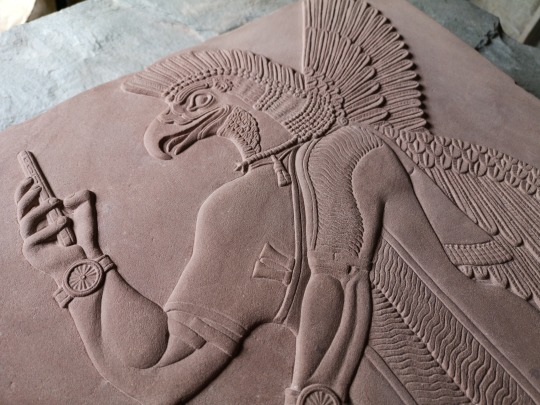

Out of place artifact.
Hand carved sandstone, based on an ancient Assyrian Winged Genie, but with a twist.
#carving#stone carving#art#traditional art#sculpture#assyrian#ancient history#archeology#history#ancient artifacts#mesopotamian art#mesopotamia#mesopotamian#genie#ancient art#ancientmonuments#antiquities#neoassyrian
132 notes
·
View notes
Text
The Lion of Mari, from Syria (Mesopotamia) c.1782-1759 BCE: this is one of two lion statues that once guarded the entrance to a temple in ancient Mari; the lions were partially crushed when Hammurabi laid waste to the city in 1759 BCE
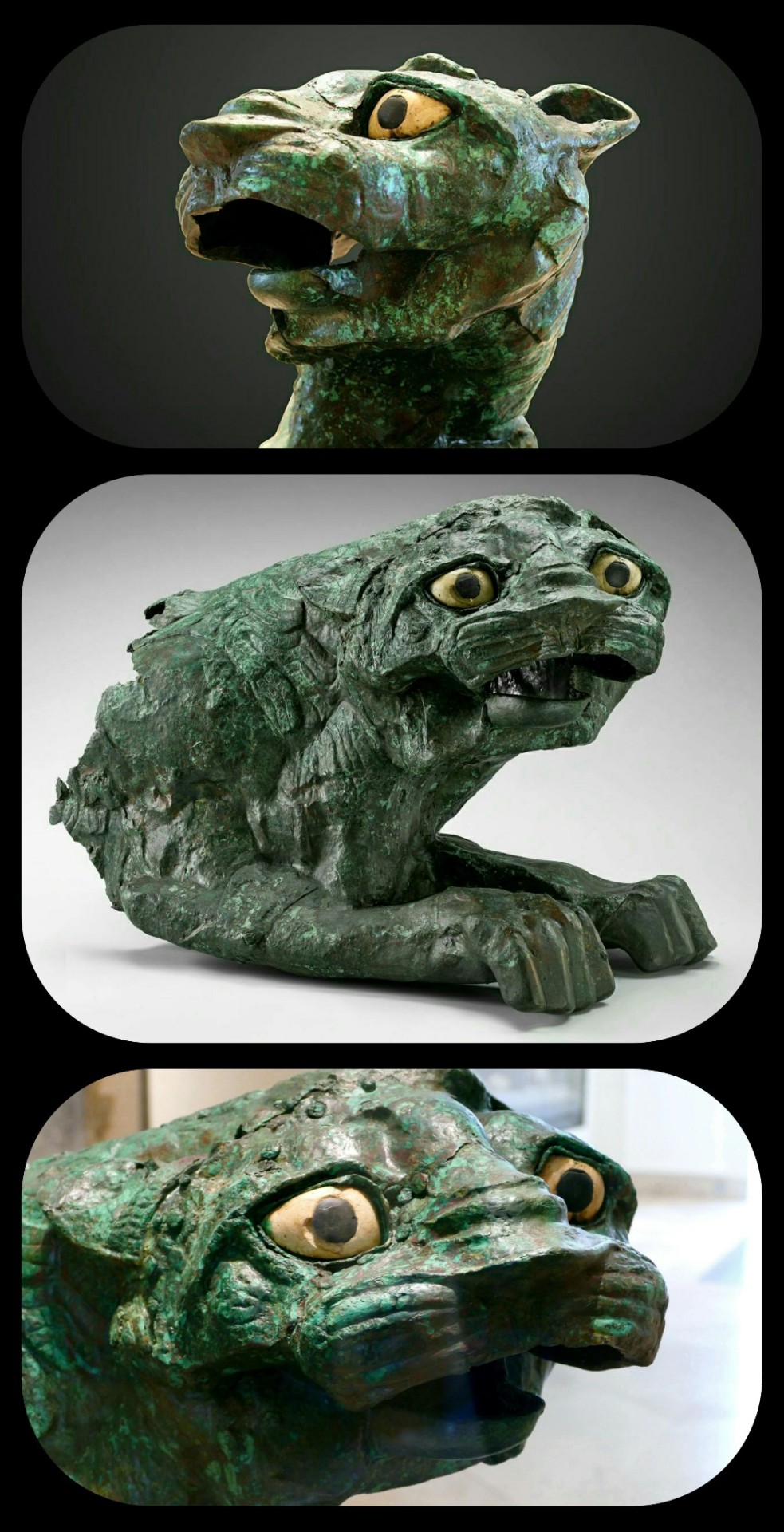
That's a pretty fitting expression, given the circumstances
Together, the two lion statues that were found at the ruined temple are known as the "Lions of Mari." They were unearthed from the ruins at Tell Hariri, where the ancient city-state of Mari once stood; this site is located near the border between modern-day Syria and Iraq.
The lions were likely designed as protomes, given their lack of hindquarters. They were originally stationed on either side of the entrance to the temple, so they are often described as the "temple guardians."

This is the same statue that appears in the first three photos, just seen from a different angle
It's believed that the temple at this site was originally built in honor of a West Semitic deity known as Dagan. Dagan was the chief deity of the Mariote pantheon; he was a particularly prominent figure in the middle and upper regions of the Euphrates, with cult centers in Mari, Terqa, Tuttul, and Ebla, but he was known throughout many parts of the ancient Near East.

The lion is primarily made of copper, with limestone and shale inlay for the eyes, and it measures 53cm tall, 77.5cm long, and 43cm wide, weighing roughly 55kg (about 21in x 30.5in x 17in, with a weight of 121lbs)
The Lions of Mari were partially crushed when their temple was destroyed (along with the rest of Mari) by Hammurabi's forces in 1759 BCE, leaving the statues badly warped...which is why they look really upset.
It's hard to find high-quality photos of the second lion, but he does have a particularly distinctive appearance:

This second lion was most recently housed at the National Museum of Aleppo, in Syria, though its current location/status (in the aftermath of the Syrian Civil War) remains unclear.
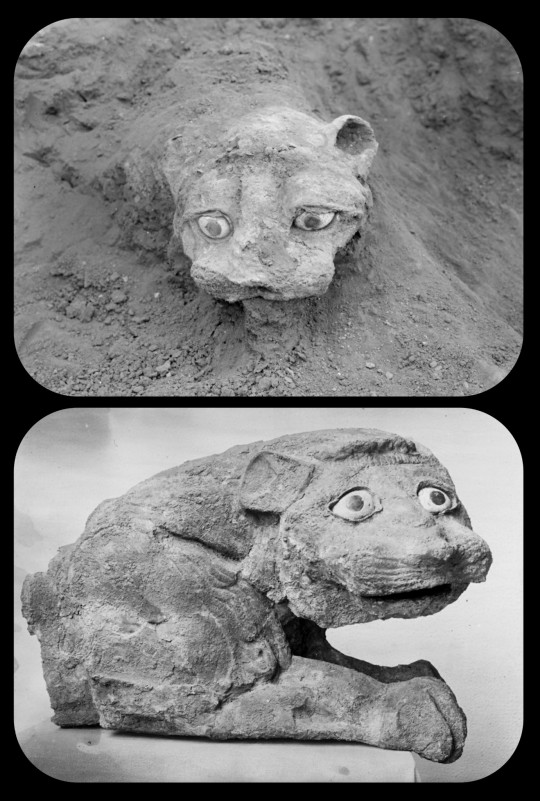
These photographs were taken during the original excavations at the ruined temple; they depict the first lion statue as it was still being unearthed (top) and the second statue shortly after it was removed (bottom)
Sources & More Info:
The Louvre: Lion of Mari
Archeologie.culture.fr: Lion Protome
Archeologie.culture.fr: Detailed Information about Ancient Mari
Virtual Museum Syria: Lion Sculpture
#archaeology#history#artifact#ancient history#art#mari#ancient temple#Syria#mesopotamia#Temple of the Lions#mesopotamian religion#ruins#hammurabi#Tell Hariri#middle east#lion#mesopotamian art#syrian archaeology#paganism#that first lion looks exactly like the way I feel
53 notes
·
View notes
Text
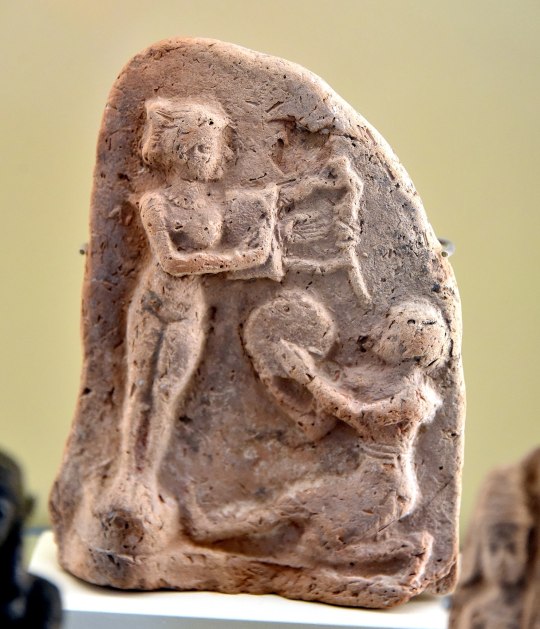
Two musicians: a woman playing the lyre and a man (?) playing the tambourine. Relief plaque from Babylon, artist unknown; 19th-17th century BCE (Old Babylonian period). Now in the Pergamon Museum, Berlin. Photo credit: Osama Shukir Muhammed Amin FRCP/Wikimedia Commons.
#art#art history#ancient art#Mesopotamia#Ancient Mesopotamia#Mesopotamian art#Ancient Mesopotamian art#Babylon#Babylonian art#Old Babylonian period#Near East#Near Eastern art#Ancient Near East#Ancient Near Eastern art#sculpture#relief sculpture#plaque#Pergamon Museum
305 notes
·
View notes
Text
For #WorldLionDay 🦁:

Head of a Lioness
Ur (Iraq) PG 800, c. 2450 BCE
Silver, Shell, Lapis Lazuli, Bitumen
Penn Museum display
“This head of a lioness, with its intensely staring eyes of lapis lazuli, was originally attached to a piece of furniture, likely a chair. The remains of the chair were found in the approach to the tomb of Puabi, Queen of Ur. Wild animals had great symbolic power. In Mesopotamia, the lioness was associated with the goddess Inana/Ishtar. The silver of this head was imported from Iran while the lapis lazuli came from far distant Afghanistan. The materials are evidence of long distance connections and the superb craftsmanship is evidence of specialized craft communities.”
#animals in art#lion#World Lion Day#animal holiday#Penn Museum#museum visit#sculpture#ancient art#Mesopotamian art#silver#metalwork
27 notes
·
View notes
Text
"Enchanting Echoes of Mesopotamia: Unveiling Mystical Realms in Myths & Legends of Babylonia & Assyria"
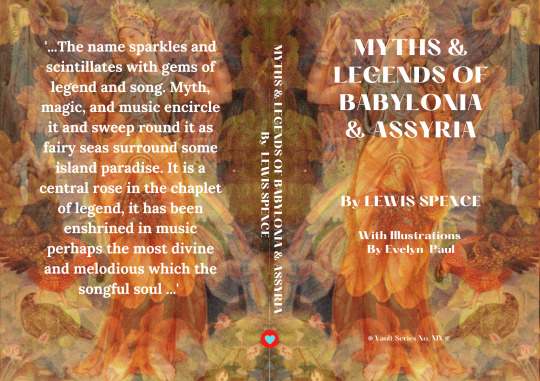
Lewis Spence's "Myths & Legends of Babylonia & Assyria" transcends time, beckoning readers into the rich tapestry of ancient Mesopotamian cultures with the enchanting grace of Evelyn Paul's illustrations. Spence, a luminary in mythological studies, skillfully navigates the complexities of Babylonian and Assyrian mythologies, breathing life into forgotten gods, heroes, and cosmic sagas. The book is a mesmerizing journey through the Euphrates and Tigris valleys, where the divine and mortal coalesce in tales of creation, epic battles, and profound wisdom.
Spence's narrative prowess shines as he unravels the intricate threads of these myths, exploring the divine pantheon with scholarly precision and a storyteller's finesse. Each page is adorned with Evelyn Paul's evocative illustrations, transporting readers to the mystical landscapes of ancient cities and sacred temples. The synergy between text and art elevates the reading experience, making the myths palpable and the legends vivid.

(Image from the book: Assur-nazir-pal attended by a Winged Mythological Being.—Bas-relief from the north-western palace at Nimrûd.—Photo W. A. Mansell and Co.)
From the creation epic Enuma Elish to the heroic exploits of Gilgamesh, Spence masterfully distills the essence of each myth, offering readers a gateway to understanding the spiritual and cultural tapestry of ancient Mesopotamia. The book becomes not just a collection of stories but a portal to another era, where gods walked among mortals, and the cosmos held secrets waiting to be unveiled.
In "Myths & Legends of Babylonia & Assyria," Spence beckons readers to delve into the heart of Mesopotamian cosmology, where chaos and order dance in eternal rhythms. This captivating exploration of ancient lore is a testament to Spence's dedication to preserving the spiritual heritage of civilizations long past. As the myths unfold, readers are left with a profound sense of awe and a renewed appreciation for the enduring power of storytelling across the ages.
Lewis Spence's "Myths & Legends of Babylonia & Assyria" is available in Amazon in paperback 15.99$ and hardcover 23.99$ editions.
Number of pages: 396
Language: English
Rating: 9/10
Link of the book!
Review By: King's Cat
#Mesopotamian Mythology#Ancient Civilizations#Babylonian Legends#Assyrian Culture#Enuma Elish#Epic of Gilgamesh#Divine Pantheon#Creation Myths#Mythological Heroes#Ancient Cosmology#Tigris and Euphrates#Sumerian Deities#Mesopotamian Art#Evelyn Paul Illustrations#Cosmic Sagas#Ancient Temples#Mythic Narratives#Spiritual Heritage#Mythological Studies#Cultural Tapestry#Enchanting Tales#Lewis Spence#Ancient Wisdom#Epic Adventures#Divine Beings#Forgotten Gods#Mythical Realms#Cultural Exploration#Mythological Journeys#Ancient Mesopotamia
13 notes
·
View notes
Text
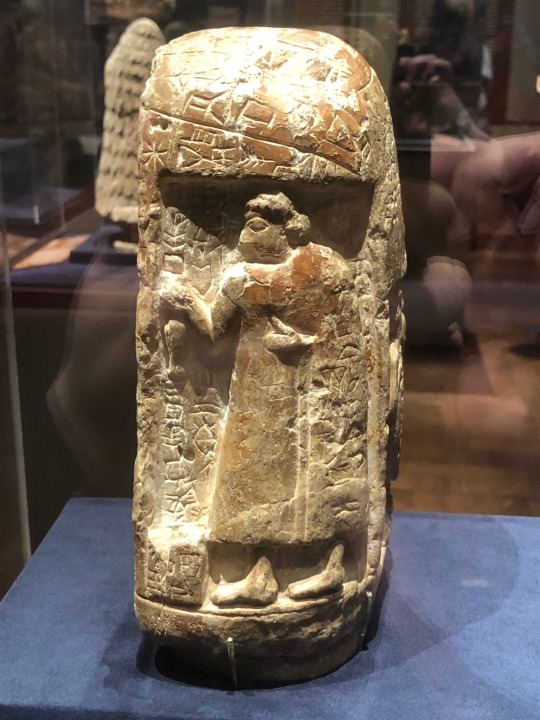

A while ago I saw an exhibit that included this carving, the oldest known piece of art that bears the artist’s signature.
It’s thousands of years old, and we know the name of the artist: Enhegal
That just gets me so emotional
(Transcript of the text is below the cut)
WOMEN OF PROMINENCE
38 Stele of Shara-igizi-Abzu
Mesopotamia, Sumerian, possibly Umma (modern Tell Jokha)
Early Dynastic I-II period, ca. 2900-2600 BC
Cuneiform inscription identifying Shara-igizi-Abzu; her father, Ushumgal; and four other represented figures, including: IGI.RU?.NUN, daughter of Mesi; Ag, chief of the assembly; Nanna, the foreman of the assembly; X.KU.EN, chief herald; Enhegal, the maker of the stele
Gypsum alabaster
This stele, bearing the earliest known signature of an artist, records one of the first transactions involving land, livestock, and houses. The two principal figures - Ushumgal, a priest of the god Shara, and his daughter Shara-igizi-Abzu - face one another on two sides. They are identified by inscriptions carved on their bodies. Shara-igizi-Abzu, who holds a vessel in her right hand, is shown taller than her father. Behind her appears a smaller female figure, and behind Ushumgal are three male figures in two registers, all of whom may have witnessed the transaction that takes place in front of a monumental building. Shara-igizi-Abzu's prominent appearance suggests that the stele documents Ushumgal's donation of an estate on her behalf.
THE METROPOLITAN MUSEUM OF ART, NEW YORK, FUNDS FROM VARIOUS DONORS, 1958; 58.29
6 notes
·
View notes
Text

Detail of Lamassu Guardian - Iraqi National Museum, Baghdad
The lamassu is a celestial being from ancient Mesopotamian religion bearing a human head, symbolizing intelligence, a bull's body, symbolizing strength; and wings of an eagle to symbolize freedom. Sometimes it had the horns and the ears of a bull. It appears frequently in Mesopotamian art.
#lamassu#iraqi national museum#baghdad#iraq#middle east#mesopotamia#mesopotamian art#ancient art#mythology#sculpture#ancient civilizations
4 notes
·
View notes
Text
"Enchanting Echoes of Mesopotamia: Unveiling Mystical Realms in Myths & Legends of Babylonia & Assyria"

Lewis Spence's "Myths & Legends of Babylonia & Assyria" transcends time, beckoning readers into the rich tapestry of ancient Mesopotamian cultures with the enchanting grace of Evelyn Paul's illustrations. Spence, a luminary in mythological studies, skillfully navigates the complexities of Babylonian and Assyrian mythologies, breathing life into forgotten gods, heroes, and cosmic sagas. The book is a mesmerizing journey through the Euphrates and Tigris valleys, where the divine and mortal coalesce in tales of creation, epic battles, and profound wisdom.
Spence's narrative prowess shines as he unravels the intricate threads of these myths, exploring the divine pantheon with scholarly precision and a storyteller's finesse. Each page is adorned with Evelyn Paul's evocative illustrations, transporting readers to the mystical landscapes of ancient cities and sacred temples. The synergy between text and art elevates the reading experience, making the myths palpable and the legends vivid.

(Image from the book: Assur-nazir-pal attended by a Winged Mythological Being.—Bas-relief from the north-western palace at Nimrûd.—Photo W. A. Mansell and Co.)
From the creation epic Enuma Elish to the heroic exploits of Gilgamesh, Spence masterfully distills the essence of each myth, offering readers a gateway to understanding the spiritual and cultural tapestry of ancient Mesopotamia. The book becomes not just a collection of stories but a portal to another era, where gods walked among mortals, and the cosmos held secrets waiting to be unveiled.
In "Myths & Legends of Babylonia & Assyria," Spence beckons readers to delve into the heart of Mesopotamian cosmology, where chaos and order dance in eternal rhythms. This captivating exploration of ancient lore is a testament to Spence's dedication to preserving the spiritual heritage of civilizations long past. As the myths unfold, readers are left with a profound sense of awe and a renewed appreciation for the enduring power of storytelling across the ages.
Lewis Spence's "Myths & Legends of Babylonia & Assyria" is available in Amazon in paperback 15.99$ and hardcover 23.99$ editions.
Number of pages: 396
Language: English
Rating: 9/10
Link of the book!
Review By: King's Cat
#Mesopotamian Mythology#Ancient Civilizations#Babylonian Legends#Assyrian Culture#Enuma Elish#Epic of Gilgamesh#Divine Pantheon#Creation Myths#Mythological Heroes#Ancient Cosmology#Tigris and Euphrates#Sumerian Deities#Mesopotamian Art#Evelyn Paul Illustrations#Cosmic Sagas#Ancient Temples#Mythic Narratives#Spiritual Heritage#Mythological Studies#Cultural Tapestry#Enchanting Tales#Lewis Spence#Ancient Wisdom#Epic Adventures#Divine Beings#Forgotten Gods#Mythical Realms#Cultural Exploration#Mythological Journeys#Ancient Mesopotamia
4 notes
·
View notes
Text


Two of my favorite pieces of ancient art at the AIC.
3 notes
·
View notes
Text
Inanna, known as the Queen of Heaven, is the Sumerian goddess of love, sex, beauty, fertility, war, power, and divine justice. The Akkadians, Babylonians, and Assyrians called her Ishtar. She was the patron goddess of the Eanna temple of the Sumerian city of Uruk.
Her symbols were the lion, the owl, the eight-pointed star, and the hamsa. Women used to wear hamsas to increase fertility and ensure healthy pregnancies. She was also associated with the planet Venus.

#inanna#mesopotamian art#mesopotamian mythology#mesopotamia#mesopotamian religion#sumerian#ancient sumeria#hamsa#ancient near east#ancient gods#middle eastern history#queen of heaven#uruk
12 notes
·
View notes
Text
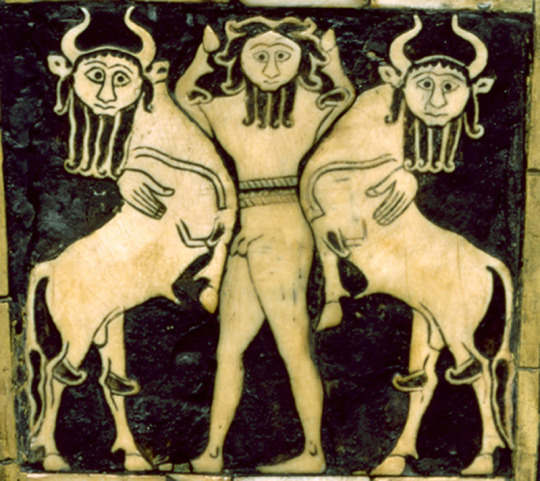
Top panel from the Bull-Headed Lyre of Ur, 2550–2450 BCE, now at the Penn Museum, Philadelphia (Object Number B17694B)
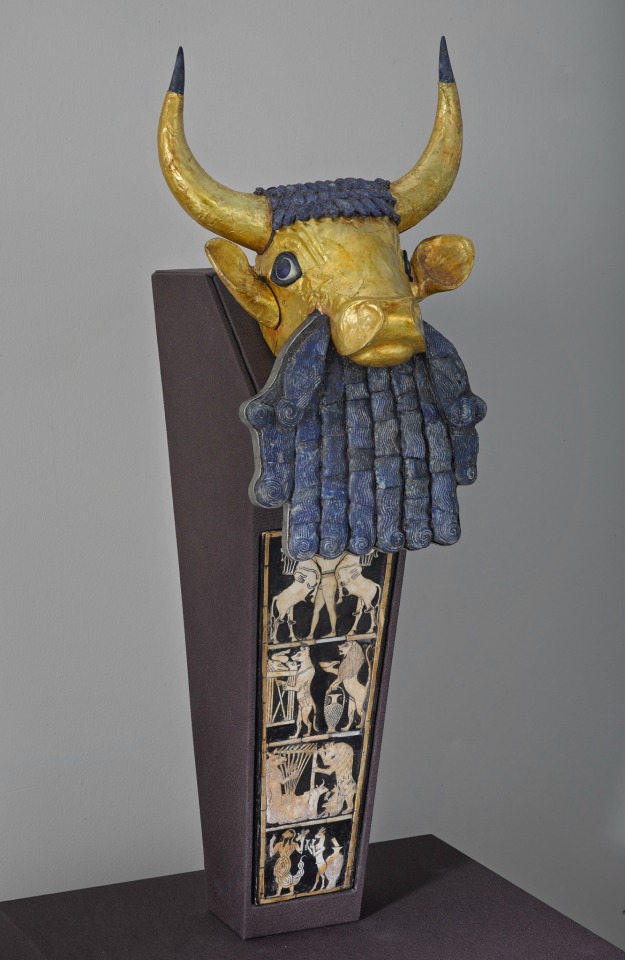
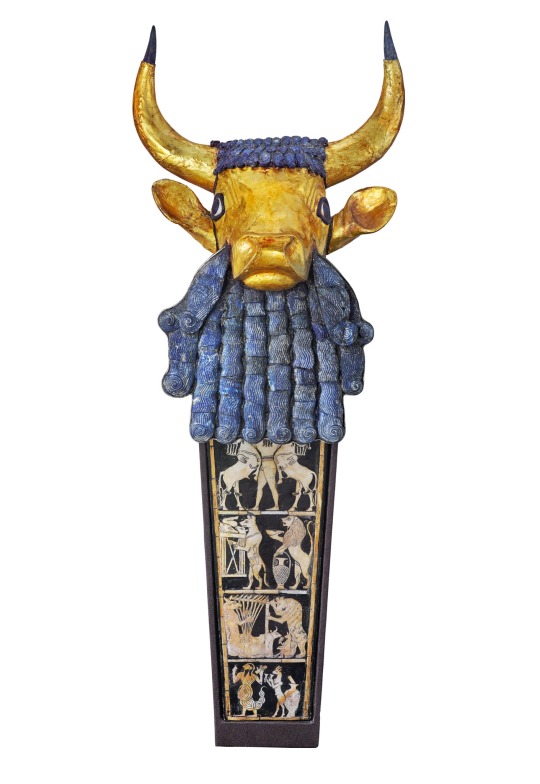
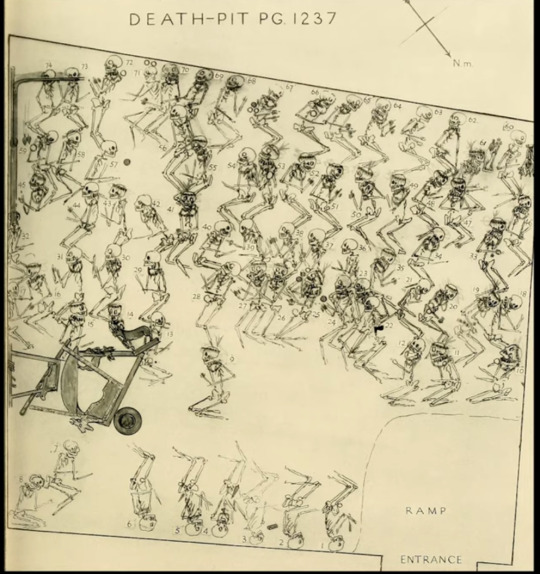
“THE BODIES IN POSITION IN THE GREAT DEATH-PIT PG/1237,” diagram showing the site where the lyre was found in the Royal Cemetery of Ur, from the report by C. Leonard Woolley.
0 notes
Text
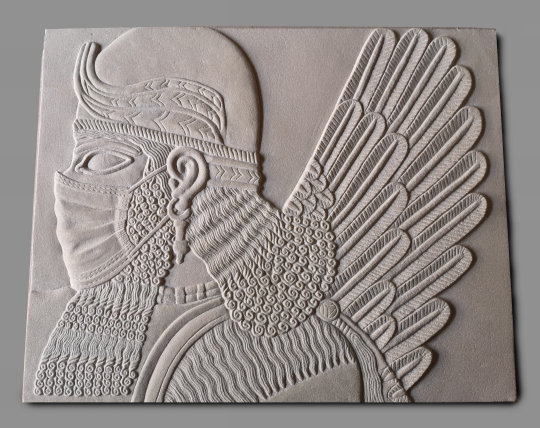
Masked Assyrian Winged Genie.
Hand carved in sandstone, now in possession of the British Museum.
Can be viewed here: https://www.britishmuseum.org/collection/object/W_2020-6011-1
#carving#stone carving#sculpture#art#traditional art#ancient history#ancient art#archaeology#antiquities#ancient civilizations#assyria#neo assyrian#ancient assyria#mesopotamia#mesopotamian art#mesopotamian#british museum#museum#the british museum#hand crafted
49 notes
·
View notes
Text

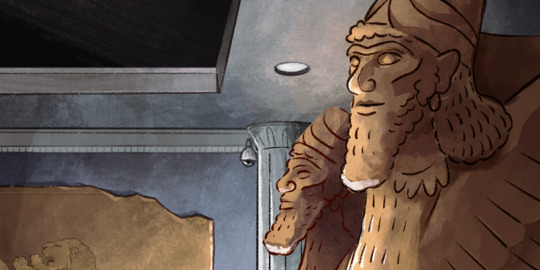
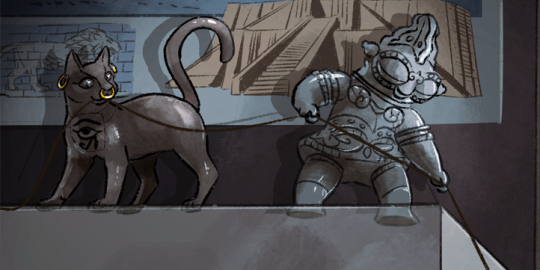


the elevator pitch for this is "a Toy Story/Night at the Museum-style educational series that teaches kids about art history"
they probably wouldn't let me have the tits-out minoan snake woman but that's ok
#illustration#my art#from left to right:#bastet#dogū#minoan snake goddess#colima dog#jizo statue#mesopotamian winged lions#i made the sketch for this back in 2020 and was too afraid to finish it#i dont think it ended up how i wanted it but im glad it ended up somewhere
2K notes
·
View notes
Text
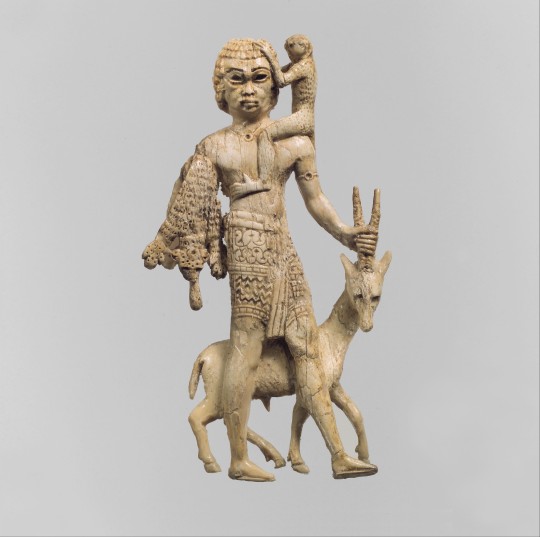
Assyrian ivory statuette group, found with other statuettes in a room at Fort Shalmaneser, Nimrud (30 km south of Mosul in present-day Iraq). A man with a leopard-skin on his right shoulder grasps the horns of an oryx, while a monkey sits on his other shoulder. Artist unknown; ca. 8th cent. BCE. Now in the Metropolitan Museum of Art.
#art#art history#ancient art#Near East#Ancient Near East#Near Eastern art#Ancient Near Eastern art#Mesopotamia#Ancient Mesopotamia#Mesopotamian art#Ancient Mesopotamian art#Assyria#Assyrian art#Neo-Assyrian#sculpture#statuette#ivory#carving#animals in art#Metropolitan Museum of Art
209 notes
·
View notes
Text
More for #WorldFrogDay:

Frog weight
Mesopotamia, Old Babylonian period, c.2000–1600BCE
Stone (diorite or andesite)
12.3 x 21.8 cm, 4.7 kg
inscription: "a frog [weighing] 10 minas, a legitimate weight of the god Shamash, belonging to Iddin-Nergal, son of Arkat-ili-damqa."
Metropolitan Museum of Art, New York
With two bonus hematite babies!

Weights in the shape of frogs
Mesopotamia, Iran, or Cyprus, early 2nd millennium BCE
Hematite
1.12 x 1.5 x 2.62 cm & 1.4 × 0.9 × 0.8 cm
Metropolitan Museum of Art, New York [1] [2]
Photographed on display at the Met in NYC.
#frog#frogs#amphibians#Babylonian art#Mesopotamian art#ancient art#weight#weights and measures#sculpture#stone sculpture#hematite#Metropolitan Museum of Art New York#animal holiday#World Frog Day#museum visit#animals in art
78 notes
·
View notes
Text

Judith holding the Head of Holofernes by Jean-François Godefroy
#judith#holofernes#art#jean françois godefroy#judith and holofernes#biblical#bible#assyrian#assyria#general#book of judith#bethulia#siege#war#camp#tent#city#religion#religious art#christianity#christian#jewish#nineveh#nebuchadnezzar#mesopotamia#mesopotamian#sword#helmet#shield#heroine
86 notes
·
View notes